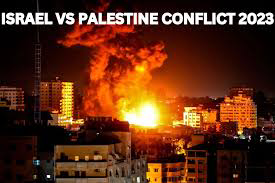The Israel-Gaza conflict is a long-standing and deeply complex issue that has resulted in numerous conflicts, with the most recent major escalation occurring in May 2021. This blog will provide an overview of the conflict's historical context, key events, and the underlying issues that continue to fuel tensions between Israel and Gaza.
Israel Gaza Conflict
Historical Background:
The Israel-Gaza conflict has its roots in the broader Israeli-Palestinian conflict, which dates back to the late 19th century when Jewish immigration to Palestine began. The conflict intensified with the creation of the State of Israel in 1948, leading to the first Arab-Israeli war. Gaza, a coastal strip of land along the Mediterranean, has been a focal point of conflict since that time.
Key Players:
Israel: The modern State of Israel was established in 1948. It is a Jewish-majority country, and its government views the entire city of Jerusalem as its undivided capital.
Palestinian Authority: The Palestinian Authority (PA) administers parts of the West Bank under the Oslo Accords and is based in the city of Ramallah. It is recognized internationally as the representative of the Palestinian people.
Hamas: A Palestinian political and military organization that controls the Gaza Strip. Hamas is considered a terrorist organization by Israel, the United States, and the European Union.
Key Issues:
Territorial Disputes: One of the core issues is the territorial dispute between Israel and the Palestinians. Both sides claim historical and religious rights to the same land.
Refugee Status: The Palestinian refugee issue dates back to the 1948 Arab-Israeli war, and many Palestinians claim the right to return to homes they or their ancestors were displaced from.
Jerusalem: Jerusalem is a holy city for Jews, Muslims, and Christians, and its status has been a major point of contention.
Security Concerns: Israel cites security concerns as a reason for maintaining control over certain territories, while Palestinians argue that these measures are oppressive and a violation of their rights.
Recent Escalations:
The conflict saw a significant escalation in May 2021. The immediate triggers for the conflict included tensions in Jerusalem, particularly in the Sheikh Jarrah neighborhood, and clashes at the Al-Aqsa Mosque. This led to rocket attacks from Gaza and Israeli airstrikes in response. The violence lasted for 11 days and resulted in significant casualties on both sides, including many civilians.
The conflict attracted international attention and concern, leading to a ceasefire brokered by Egypt and facilitated by international actors.
Possible Paths to Resolution:
Achieving a long-lasting resolution to the Israel-Gaza conflict is highly complex and challenging. Some potential paths to resolution include:
Negotiations: Diplomatic negotiations between Israel and the Palestinian Authority could potentially lead to a two-state solution, where Israel and a Palestinian state exist side by side.
Ceasefires and Peace Initiatives: Continued efforts to negotiate and maintain ceasefires, as well as international peace initiatives, are essential in preventing further violence.
Addressing Root Causes: Addressing issues such as settlement expansion, refugee rights, and the status of Jerusalem are crucial for resolving the underlying conflicts.
International Engagement: The international community, including the United Nations, can play a significant role in mediating and facilitating a peaceful resolution.
The Israel-Gaza conflict is a deeply entrenched and multifaceted issue, and achieving a lasting peace remains a formidable challenge. However, it is essential for the well-being and stability of the region and its people.


